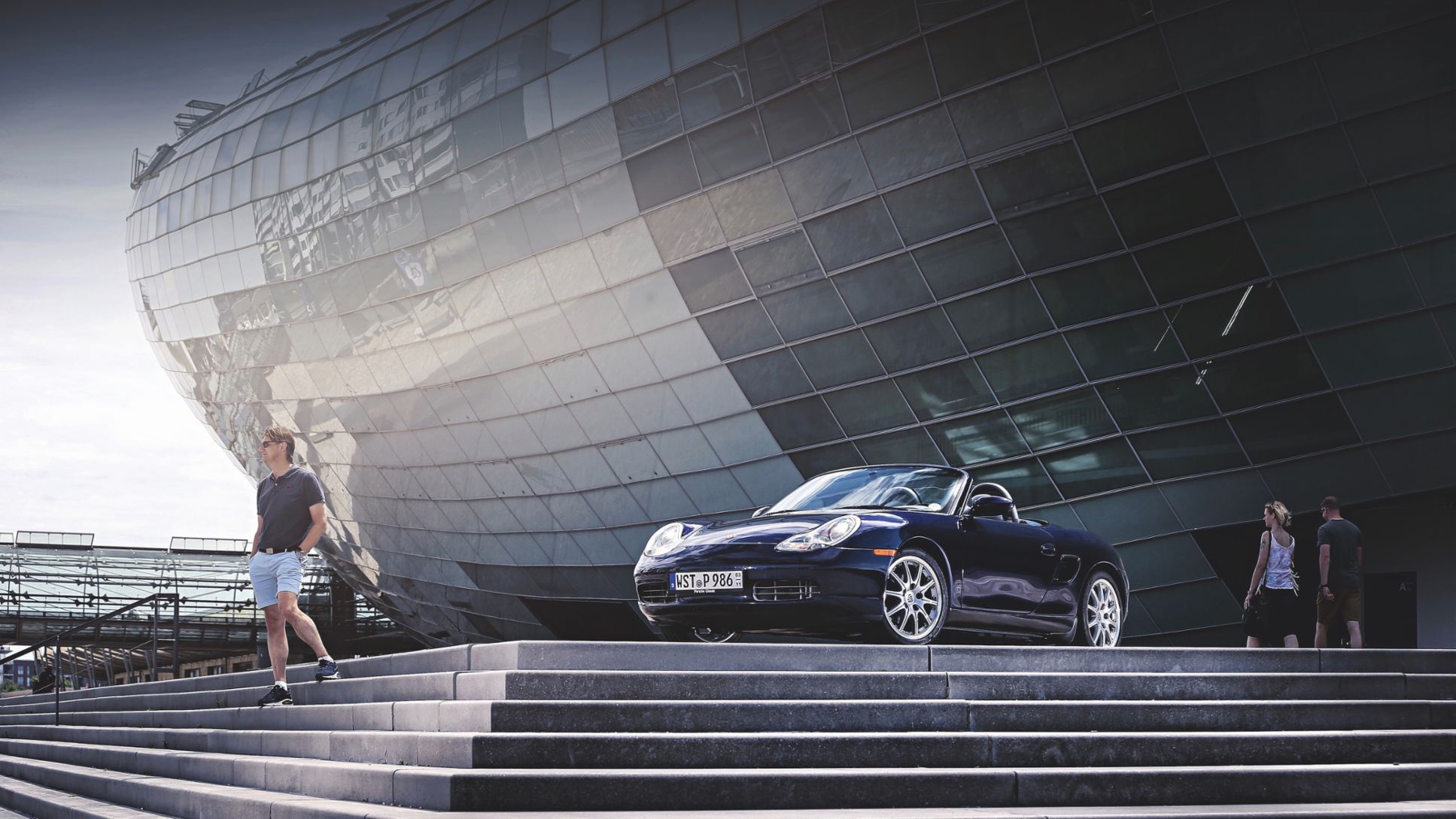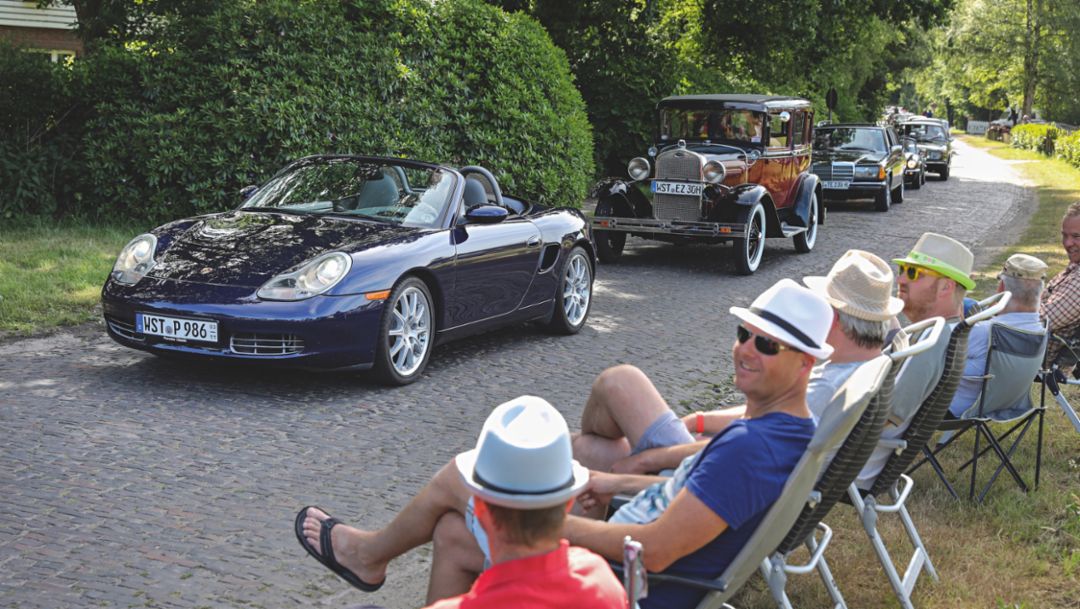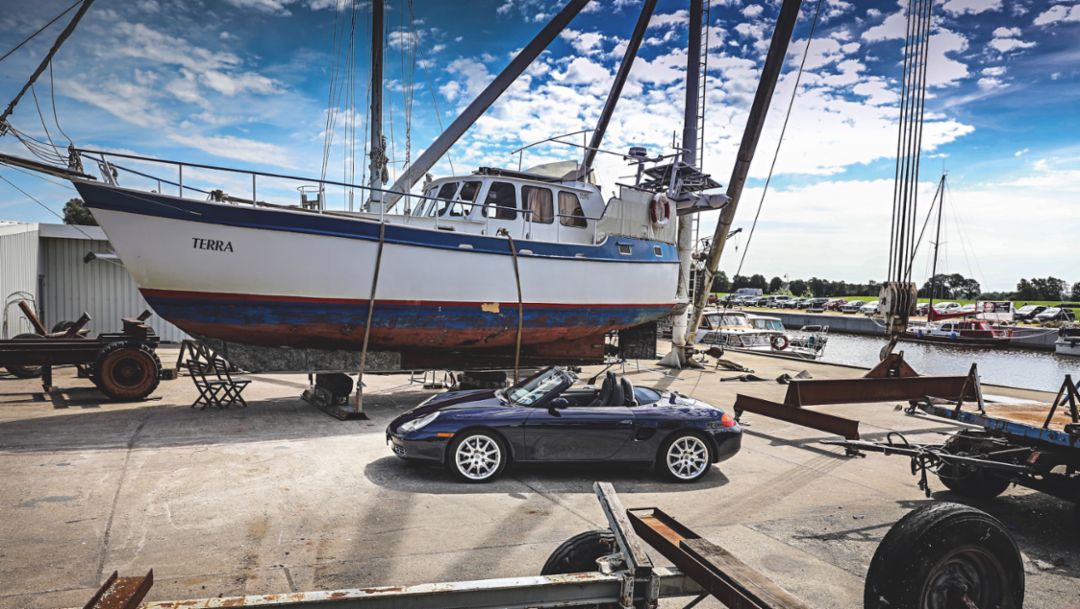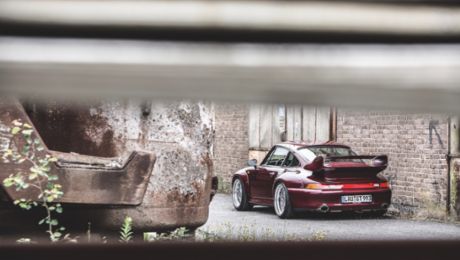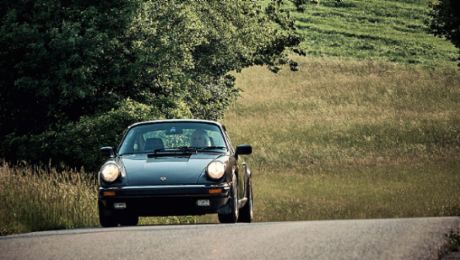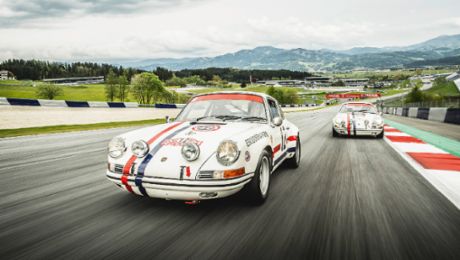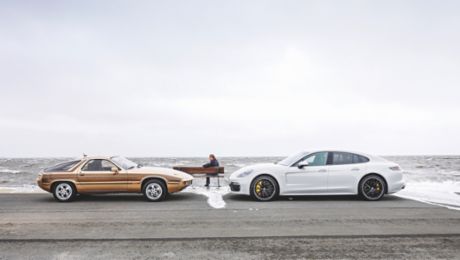There is no shortage of classic vehicles of the future – merely used cars today, but destined to join the the stable of sought-after classics and modern classics in just a few years, and already able to delight drivers just as much as a 964, 968 or 993 vehicle of the previous era. The Porsche Boxster 986 is one of these cars. Built between 1996 and 2004, many of us will soon be kicking ourselves for not buying one while they were still available for a reasonable price. The Porsche Klassik team has therefore taken one for the team — and bought a 986. You can read its story below. It might help you to track down similar vehicles for your driving enjoyment.
Let’s hop back in time to summer 2017. One of the most popular and largest classic car shows in Germany is taking place in Bockhorn. It attracts a crowd of 20,000 visitors, many of whom come with their classic and modern classic cars. This year, there are 5,000 of these vehicles. Any vehicle built before 1992 can park for free in the cordoned-off centre of the showground. This is because cars must be at least 25 years old to be officially recognised as classics by those in the know. Our “new” Boxster 2.7 is a mere youngster of 15. It was built in June 2002 and purchased a few days ago in Berlin, from a reputable dealer. For a comparatively small amount of money. At the moment it’s a wanderer between worlds. We’re on tenterhooks to see how it will be received in Bockhorn. The wait is over right at the entrance to the free car park for classic and modern classic vehicles. The guys at the entry gate know their stuff: “Can we take a quick peek at the car’s registration documents?” When we explain who we are and what we want, they declare our Boxster a “super modern classic” on the spot and invite us to join the parade of classic vehicles through the showground (for which we will be eternally grateful!).
The Porsche 986 amidst the genuine classics
Hundreds of fans of classic vehicles line the road to watch this invasion of automotive gladiators. None of them finds it odd that our young old-timer is driving amidst the genuine classics. This is a widespread phenomenon. The first few people we ask can no longer remember exactly how old a 986 ought to be. Even though – or perhaps because – the first generation of these vehicles is currently in a kind of quasi limbo. It’s not uncommon to find run-down 986s whose beauty is slowly fading parked on the streets of major cities, quietly rusting away in the glow of the streetlamps. At the other extreme, there are cars which are lucky enough to have come through the years and the miles with only one or two (wealthy) owners and a full service history. There are a great many 986 vehicles in this category. After all, exactly 164,874 units were sold worldwide between 1996 and 2004 (source: Porsche Archive). Mostly to first owners who were sensible enough to take their cars for regular servicing and not park them under streetlamps.
This was the kind of car we were looking for. We found it in Berlin, at Lundtauto Classic GmbH. Certain experts advise against buying classic vehicles registered in large cities. As ever, though, it’s important not to generalise. Even in cities like Berlin, most Porsche vehicles are parked in garages. And – as we hinted above – those left to their fate under streetlamps are either in an unmistakeably sorry state of repair or have long since been stolen. The Boxster 2.7 (model year 2002) that we purchased from Lundtauto Classic for less than 18,000 euro had whiled away many pleasant years in garages. A certain patina on the hood did reveal that there might have been the odd occasion when a horse chestnut tree served as its protection from the elements. But its overall appearance was entirely satisfactory, as were all its other characteristics.
We had been deliberately looking for a Boxster 986 2.7 just like this one. The initial search parameters we used on mobile.de were very clearly defined: “Germany”, “No more than two owners”, “First registration between 1999 and 2004”, “Manual transmission”, “Up to 80,000 km” and “Xenon”. Entering only “Germany” and “Built before 2004” returned several hundred hits. Including many misses such as right-hand drive vehicles. By using search filters, however, we were able to slash the list to only 10 cars. We did not place a checkmark in the box for “Full service history”, because private sellers often forget to click here even though their vehicles possess a flawless maintenance record. All of the other filters for our online search made perfect sense, however. “Germany”: It goes without saying that perfectly respectable Boxster vehicles can be found in the Netherlands, Switzerland or Austria. However, there are simply more of them in Germany, not to mention that they are often described in greater detail – and the legal rules which would apply in the event of a dispute are more transparent. “No more than two owners”: The number of previous owners is inversely related to the long-term value of a classic vehicle. This is because the first or second owner of the car normally takes the car for regular servicing and has enough money to spend on repairs.
Boxster 986 with manual transmission win in the popularity stakes
“First registration between 1999 and 2004”: The Boxster celebrated its 20th birthday last year. It debuted in 1996 with a 2.5-litre engine which delivered 204 hp. Top-condition models from this first production series run are an enticing prospect, but the facelifted Boxster vehicles from 1999 onwards with 2.7 litres and 220 hp (228 hp from 2002 onwards) or – in the shape of a Boxster S – 3.2 litres and 252 hp (260 hp from 2002 onwards) are more fun to drive. 2.7-litre engines which have not been overworked are regarded as being particularly stable. It is often claimed that performance only really took off with the “S” models. Those claims are wrong, however, because even the 220 hp version has adequate dynamics for cruising at high speed. The 2.7-litre models were after all equivalent to a 911 Carrera 3.2 (1983 to 1989) in terms of performance. “Manual transmission”: In general terms, Boxster 986 vehicles with manual transmission win in the popularity stakes. And there’s a good reason for that. The automatic 5-speed Tiptronic transmission with torque-converter lockup clutch falls far short of today’s PDK double-clutch transmission in terms of agility. The manual versions are therefore by far the most dynamic and the superior choice for a Porsche of that era. “Xenon”: The light output is better by light years, and the xenon lenses are more charismatic. “Up to 80,000 km”: This search filter is self-explanatory. There are still plenty of Boxster vehicles around with under 70,000 km on the clock. In this case, less is most definitely more.
Anyone who gets under the bonnet of the first water-cooled flat engines will however inevitably come across small leaks, for example from the transmission-side crankshaft sealing ring. A service history without gaps can help in this respect. You can drive away from the dealer’s forecourt with at least some degree of confidence if the sealing ring has been replaced at some point. There is no guarantee that the seal will hold forever, but you have a much higher chance of many care-free summers spent driving around the countryside. For Boxster vehicles produced around 15 years ago, it is also encouraging if the components which appear on repair bills include new wishbones and stabiliser bushings at the front, new shock absorbers, new tension struts, new spring struts and new brake discs, to name but a few. These are things which wear out and will eventually need to be replaced. Anyone who can find a Boxster which comes with a thick wad of repair and maintenance bills is therefore in luck. This was the case with our Boxster from Berlin. But there’s always something that needs replacing, even if maintenance tasks are carried out promptly. The biggest job to tackle in our Boxster was the hood. When we bought the vehicle, we could see that the seams below the hood compartment were torn. That can mean only one thing: replacement of the outer skin. After one and a half decades, however, that will generally appear on any to-do list. Another component which is often faulty is the LCD display of the automatic climate control system. It’s important not to fall into the trap of ordering a whole new climate control panel. A new display can be purchased for a much cheaper price, for example from the eBay seller “WPO” for less than 80 euro (with installation instructions).
This is exactly the display we installed, and it works perfectly. The PCM1 – the first Porsche Communication Management system – installed in the Boxster until mid-2002 is also prone to giving up the ghost. This is often due to a faulty mainboard. Repairs cost around 550 euro but are well worth the price, since a working PCM restores access to functions such as the on-board computer, telephone and navigation system (the last card and system update in 2011 by Navteq/Continental Automotive for Opel is compatible). Buyers should be alert to other details which characterise the Boxster from Berlin. The 986 has not been repainted. It has a leather interior, including the dashboard and door panels. Full leather fittings are a sine qua non for 986 collectors, since they offer a stylish substitute for the less-sophisticated plastics of this era. Special features which are no less stylish and which make the Porsche roadster even more exclusive include the Porsche crest on the headrests, a centre tunnel in the same colour as the car and a painted roll-over bar.
15 years is a long time for the soft top on a cabriolet, and time had certainly left its mark on the hood of our Boxster. A seam at the rear, which can only be seen when the hood compartment lifts in order to open and close the roof, had been particularly affected by the many years of wear. This meant that the tensioning was no longer correct, and there was no other option than to replace the outer skin. Professional saddlers are the only people who can do this job properly. The custom fitting of a new hood on an old car requires a level of craftsmanship which is generally lacking in normal workshops. Even Porsche Centres generally use the services of a saddlery in such cases. We chose the third-generation family firm Autosattlerei Mönnich in the Lower Saxony city of Oldenburg. Fabrics and leather have been processed here with consummate skill since 1921. Any owner of a classic vehicle which needs a new hood should do themselves the favour of hunting down a saddlery of this kind. After all, the saddler’s craft is one of the original arts of the automotive industry. It is only when a soft top is replaced that one realises the underlying complexity of a cabrio’s tent-like roof, which appears so straightforward at first glance.
The quality demands of a sports car
The Boxster painted in Lapis Blue Metallic was given a new soft top in a blue Sonnenland A5 fabric. The colour corresponds to the Metropolis Blue of the original, and the fabric meets the quality demands of a sports car which is no stranger to speeds of 200 km/h. The new outer skin is tensioned extremely tightly to ensure that the soft top remains in exactly the right position for many years to come.
The hood of our Boxster, which was registered in June 2002, also has a plastic rear window made from Wopavin. To avoid damage from kinks, it’s a good idea to use one arm to smooth the window outwards when opening the roof. We advise against retrofitting the glass windows that were available from model year 2003 onwards, since this would generally modify the design to the extent that it would no longer resemble either the original up to model year 2002 or the successor from model year 2003 onwards.
The kind of Boxster soft top installed by Mönnich generally costs at least 2,500 euro inclusive of fitting. Quite an investment, but one which will restore a used Boxster to mint condition.
Info
Text first published in the magazine "Porsche Klassik 12".
Text by Thomas Fuths // Photos by Stephan Lindloff and Thomas Fuths
Copyright: The image and sound published here is copyright by Dr. Ing. h.c. F. Porsche AG, Germany or other individuals. It is not to be reproduced wholly or in part without prior written permission of Dr. Ing. h.c. F. Porsche AG. Please contact newsroom@porsche.com for further information.
